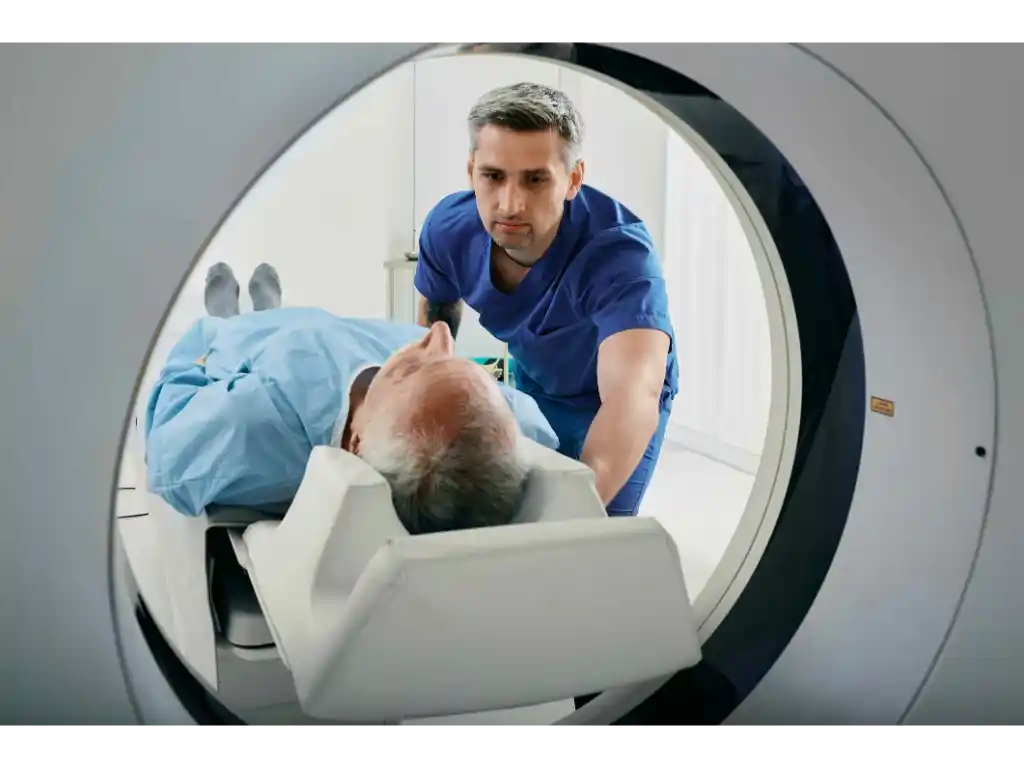
Researchers Find Brain Lesions in MRIs Linked to Years of Playing Football
When doctors scan a person’s brain after a head injury, they can see markers of the damage to the brain’s white matter, known as white matter hyperintensities. A recent study that compared the brain scans of athletes who competed in contact sports throughout their lifetime with the results from their autopsies revealed that the white matter hyperintensities in their brains was associated with neuropathological changes.
The research was published in the American Academy of Neurology’s online issue of Neurology®. The study also found that white matter hyperintensities were more common in athletes who had longer careers in contact sports and sustained more head impacts while competing.
Areas of the brain with white matter hyperintensities show up bright on magnetic resonance imaging (MRI) scans. White matter hyperintensities is common in people as they get older and in those with medical conditions like high blood pressure.
According to the author of the study, Michael Alosco, PhD, of the Boston University School of Medicine, the results are significant because “they show that white matter hyperintensities might capture long-term harm to the brain in people who have a history of repetitive head impact.” Alosco also said that
“White matter hyperintensities on MRI may indeed be an effective tool to study the effects of repetitive head impacts on the brain’s white matter while the athlete is still alive.”
The study involved 75 people who had endured repetitive head impacts and reported symptoms. 65 of the subjects were football players, while 8 of the others competed in contact sports like soccer and boxing, or they were military veterans. All the football players in the study played an average of 12 years. 16 football players in the study also played at the professional level, while 11 competed at the semi-professional level.
All of the participants in the study donated their brains to research after they passed away to help advance studies into the long-term effects of repetitive head impacts and traumatic brain injuries. Researchers reviewed the participant’s medical records, including scans of their brains taken while the athletes were still alive. Participants in the study had scans taken of their brains, on average, at age 62. The average age that participants died was 67.
Based on discussions with the participants’ loved ones, 64% likely had dementia before they died. Autopsies of the participants showed that 53 of them, or 71%, had chronic traumatic encephalopathy (CTE). CTE is a neurodegenerative disease that can progress to dementia. Scientists have linked CTE to concussions and repetitive head impacts, like those sustained in football other contact sports.
After researchers examined the athletes’ brain scans, they discovered that for every unit difference in white matter hyperintensity volume, there was about twice the odds of the subject having more severe small vessel disease and other indicators of white matter damage. Researchers also found that there was three times the odds of having more severe tau accumulation in the frontal lobe of the brain. Tau protein accumulation in the brain is sign of progressive brain diseases, such as Alzheimer’s disease and CTE. Researchers also found that higher amounts of white matter hyperintensities were associated with the longer the athletes played football.
Lastly, researchers discovered that greater amounts of white matter hyperintensities were associated with higher scores on a questionnaire the brain donors were given about their ability to complete daily tasks. While Dr. Alosco noted that there are “key limitations to the study,” he also pointed out that additional research needs to be conducted to “determine the unique risk factors and causes of brain lesions in people with a history of repetitive head impact.”
Some limitations of the study included the fact that the MRIs used were obtained for clinical, not research purposes. The participants in this study were also mostly older, symptomatic, male, former American football players.
To read the full research paper, please click here.
We Handle Cases Involving Concussions & Other Brain Injuries in Sports
At Scarlett Law Group, our team of experienced attorneys know that traumatic brain injury is common in contact sports. Although repeated concussions can lead to brain atrophy and cumulative neuropsychological deficits like CTE, many physicians, coaches, athletes, and athletic trainers continue to trivialize and dismiss these types of serious brain injuries. That is why our firm is committed to using our extensive resources and knowledge of the law to help clients recover compensation and hold any negligent parties responsible for wrongdoing that contributed to their brain injuries.
Our law firm has recovered multi-million dollar results for our clients, and we are ready to put our skills to work for you today. Give us a call at 415-688-2176 or complete our online form to get started on your free case consultation.
Ask A Question,
Tell Us Your Situation, &
Get A Free Consultation
Contact Us & We’ll Guide You Through Your
Next Steps!
Required Fields*
Your Information Is Safe With Us.
We respect your privacy. The information you provide will be used to answer your question or to schedule an appointment if requested.
Researchers Find Brain Lesions in MRIs Linked to Years of Playing Football

When doctors scan a person’s brain after a head injury, they can see markers of the damage to the brain’s white matter, known as white matter hyperintensities. A recent study that compared the brain scans of athletes who competed in contact sports throughout their lifetime with the results from their autopsies revealed that the white matter hyperintensities in their brains was associated with neuropathological changes.
The research was published in the American Academy of Neurology’s online issue of Neurology®. The study also found that white matter hyperintensities were more common in athletes who had longer careers in contact sports and sustained more head impacts while competing.
Areas of the brain with white matter hyperintensities show up bright on magnetic resonance imaging (MRI) scans. White matter hyperintensities is common in people as they get older and in those with medical conditions like high blood pressure.
According to the author of the study, Michael Alosco, PhD, of the Boston University School of Medicine, the results are significant because “they show that white matter hyperintensities might capture long-term harm to the brain in people who have a history of repetitive head impact.” Alosco also said that
“White matter hyperintensities on MRI may indeed be an effective tool to study the effects of repetitive head impacts on the brain’s white matter while the athlete is still alive.”
The study involved 75 people who had endured repetitive head impacts and reported symptoms. 65 of the subjects were football players, while 8 of the others competed in contact sports like soccer and boxing, or they were military veterans. All the football players in the study played an average of 12 years. 16 football players in the study also played at the professional level, while 11 competed at the semi-professional level.
All of the participants in the study donated their brains to research after they passed away to help advance studies into the long-term effects of repetitive head impacts and traumatic brain injuries. Researchers reviewed the participant’s medical records, including scans of their brains taken while the athletes were still alive. Participants in the study had scans taken of their brains, on average, at age 62. The average age that participants died was 67.
Based on discussions with the participants’ loved ones, 64% likely had dementia before they died. Autopsies of the participants showed that 53 of them, or 71%, had chronic traumatic encephalopathy (CTE). CTE is a neurodegenerative disease that can progress to dementia. Scientists have linked CTE to concussions and repetitive head impacts, like those sustained in football other contact sports.
After researchers examined the athletes’ brain scans, they discovered that for every unit difference in white matter hyperintensity volume, there was about twice the odds of the subject having more severe small vessel disease and other indicators of white matter damage. Researchers also found that there was three times the odds of having more severe tau accumulation in the frontal lobe of the brain. Tau protein accumulation in the brain is sign of progressive brain diseases, such as Alzheimer’s disease and CTE. Researchers also found that higher amounts of white matter hyperintensities were associated with the longer the athletes played football.
Lastly, researchers discovered that greater amounts of white matter hyperintensities were associated with higher scores on a questionnaire the brain donors were given about their ability to complete daily tasks. While Dr. Alosco noted that there are “key limitations to the study,” he also pointed out that additional research needs to be conducted to “determine the unique risk factors and causes of brain lesions in people with a history of repetitive head impact.”
Some limitations of the study included the fact that the MRIs used were obtained for clinical, not research purposes. The participants in this study were also mostly older, symptomatic, male, former American football players.
To read the full research paper, please click here.
We Handle Cases Involving Concussions & Other Brain Injuries in Sports
At Scarlett Law Group, our team of experienced attorneys know that traumatic brain injury is common in contact sports. Although repeated concussions can lead to brain atrophy and cumulative neuropsychological deficits like CTE, many physicians, coaches, athletes, and athletic trainers continue to trivialize and dismiss these types of serious brain injuries. That is why our firm is committed to using our extensive resources and knowledge of the law to help clients recover compensation and hold any negligent parties responsible for wrongdoing that contributed to their brain injuries.
Our law firm has recovered multi-million dollar results for our clients, and we are ready to put our skills to work for you today. Give us a call at 415-688-2176 or complete our online form to get started on your free case consultation.
Post tags
Table of contents
Related Blog Posts

5 Famous Personal Injury Lawsuits That Made a Big Impact in Personal Injury Law
When you hear about personal injury lawsuits in the news, it’s usually because they involve shocking facts, high-profile people, or record-breaking settlements. But these cases aren’t just headlines. They shape how courts treat injury victims, how companies…

How Long Should a Personal Injury Case Take to Settle in Louisville, Kentucky?
If you’ve suffered injuries because of someone else’s negligence, waiting for a fair settlement can feel like one more obstacle in an already stressful situation. Medical bills are stacking up. You may be out of…

Getting Help with a Whiplash or Neck Injury
Whiplash injuries occur when a person’s body moves forward rapidly while their head stays in place. Whiplash injuries can severely impact the neck, causing the neck to extend in a “whip-like” motion. In some cases,…

